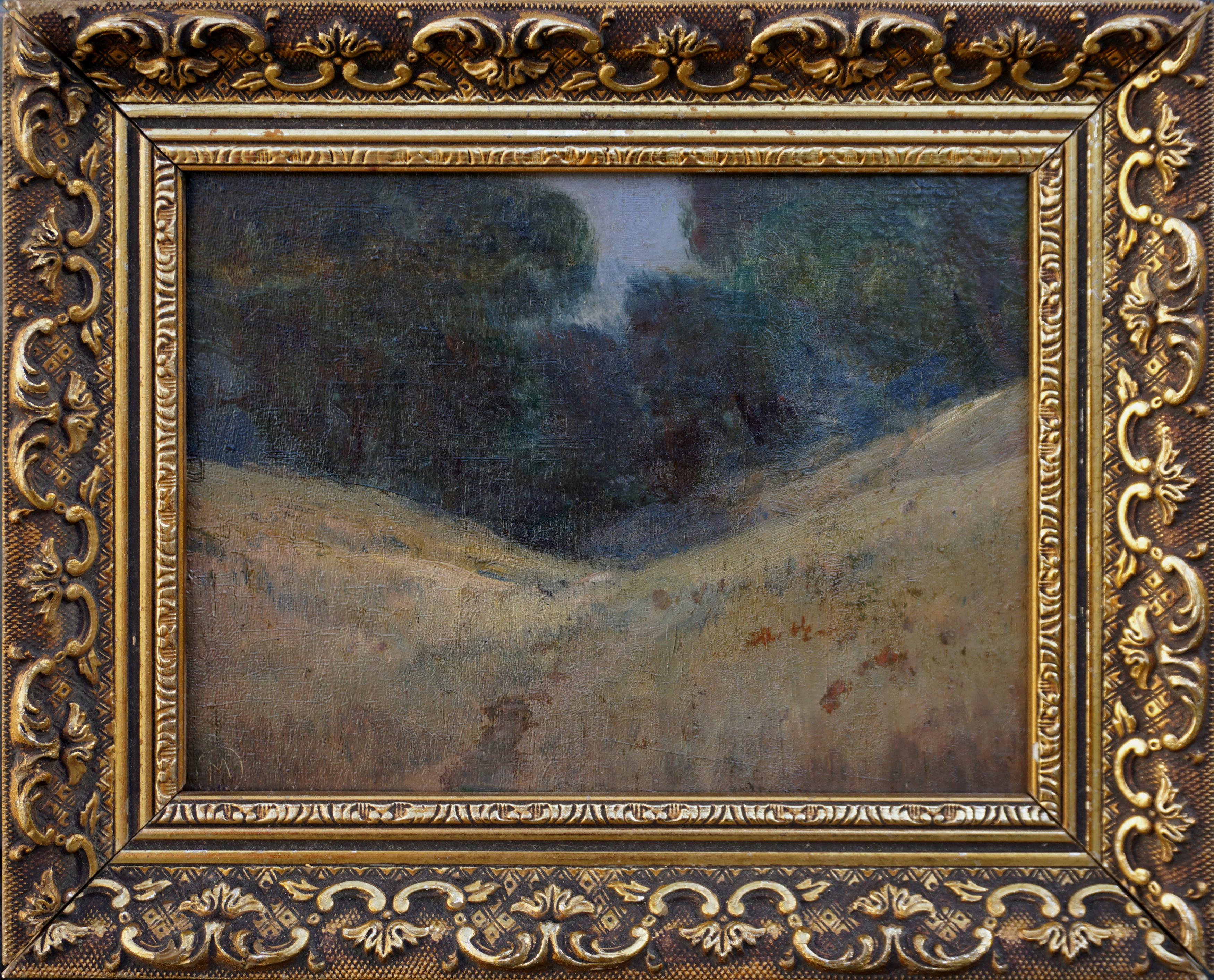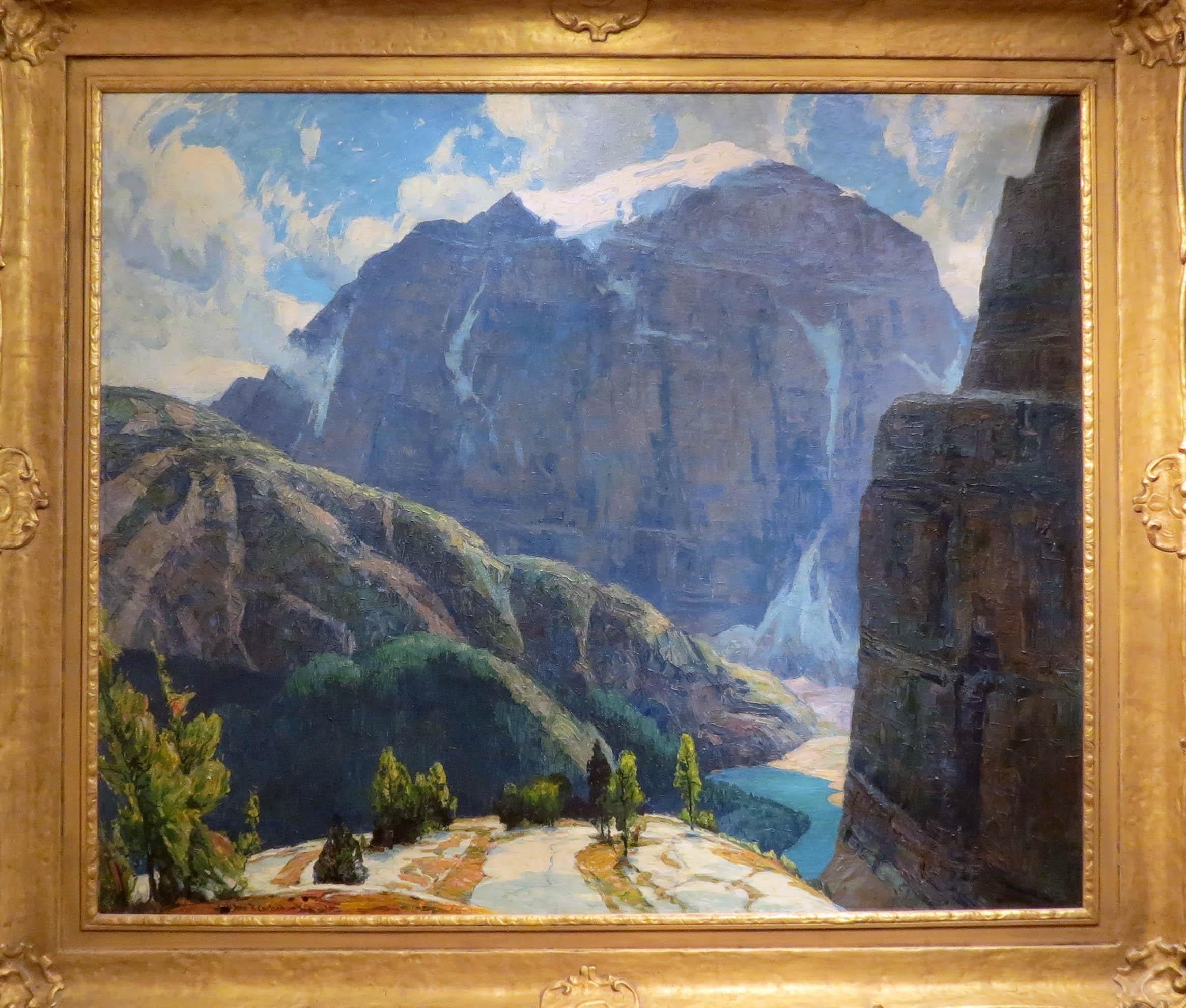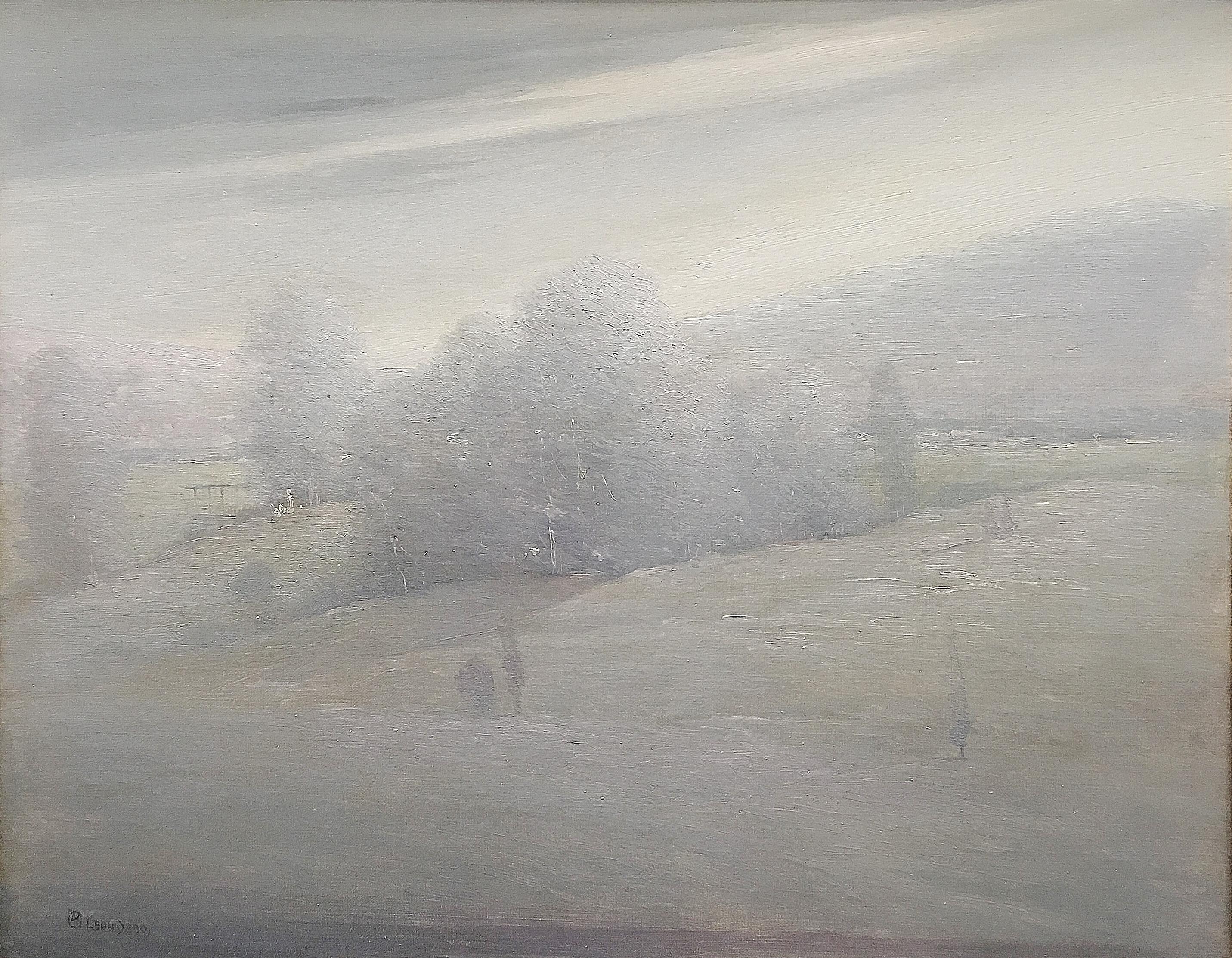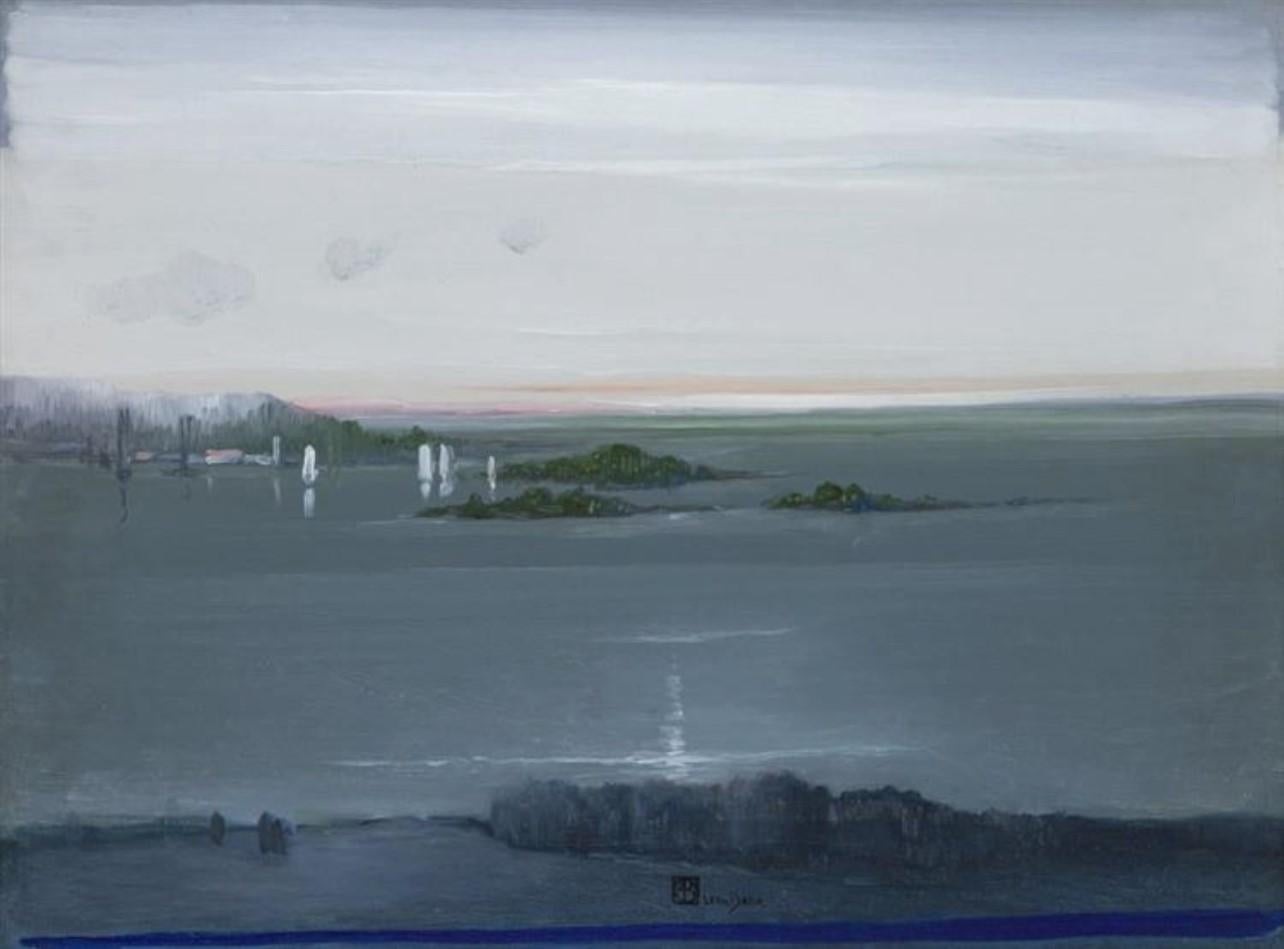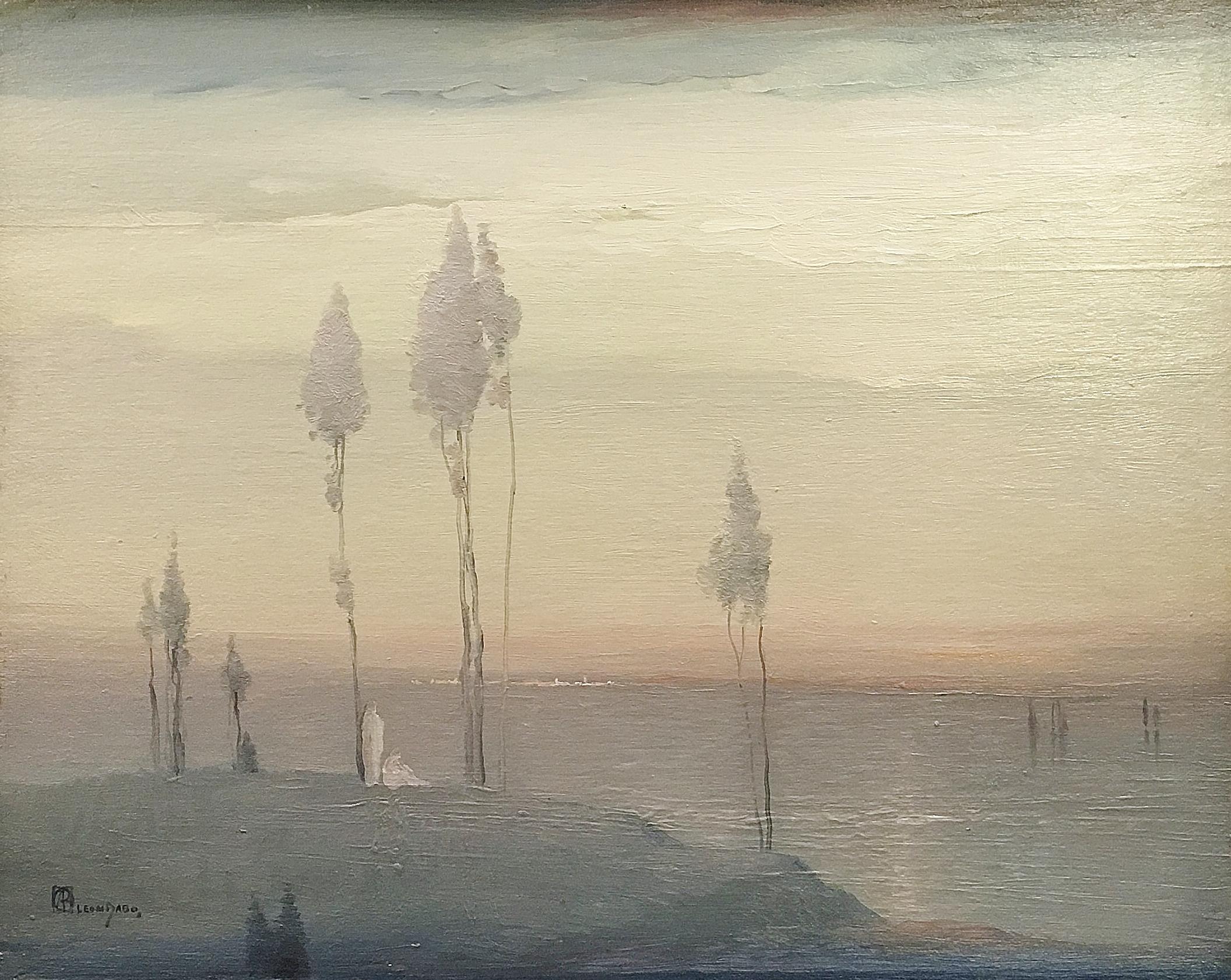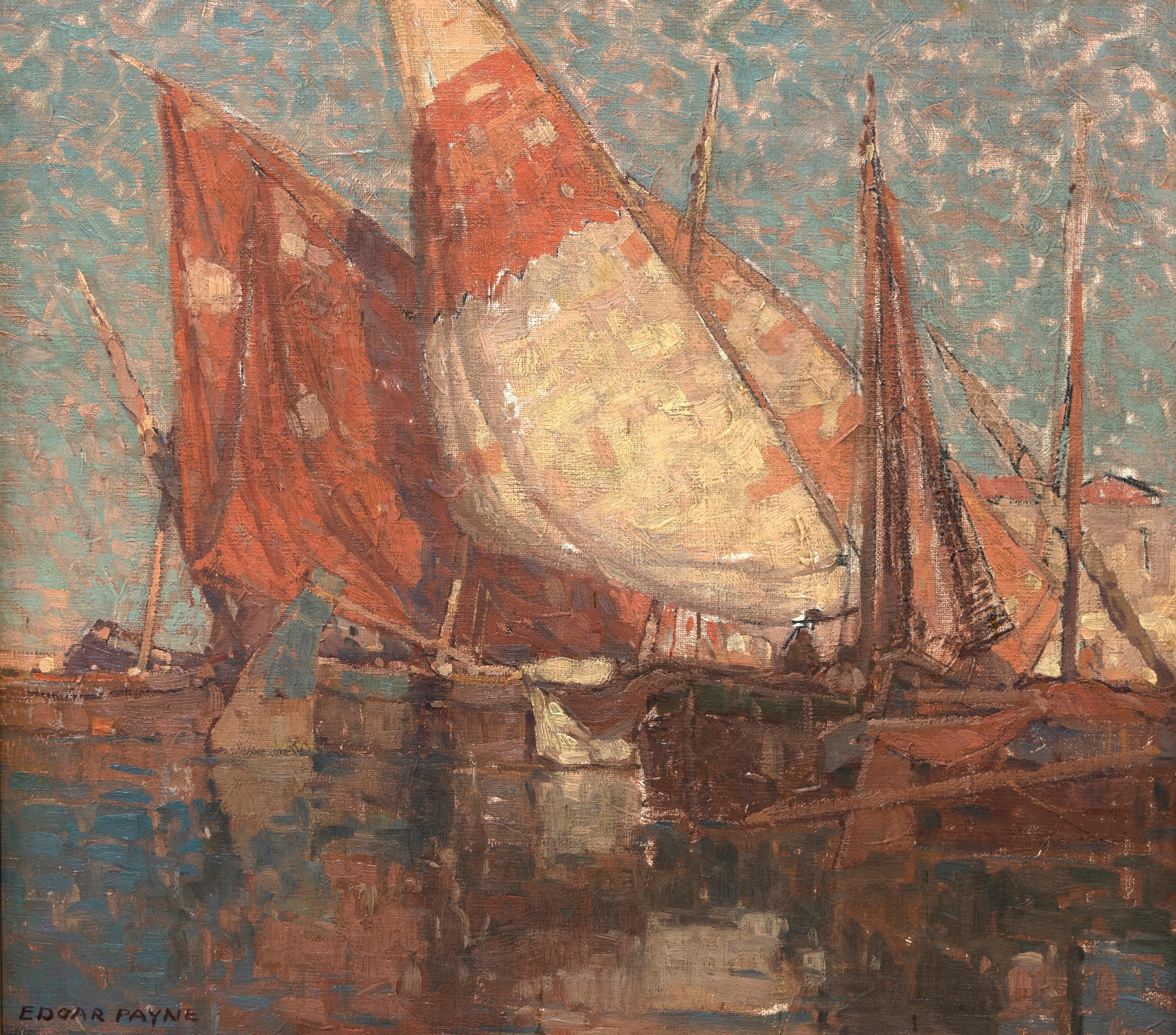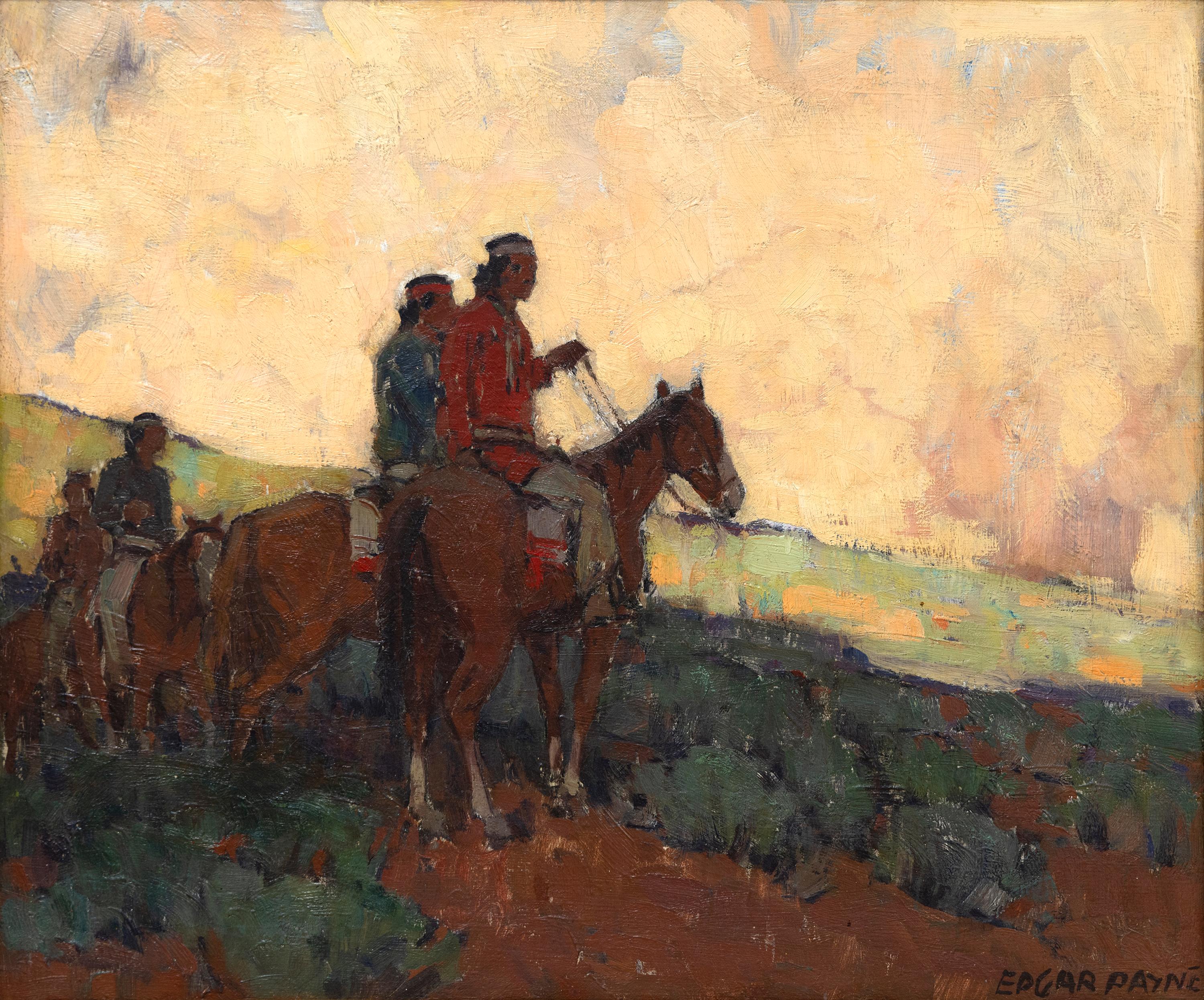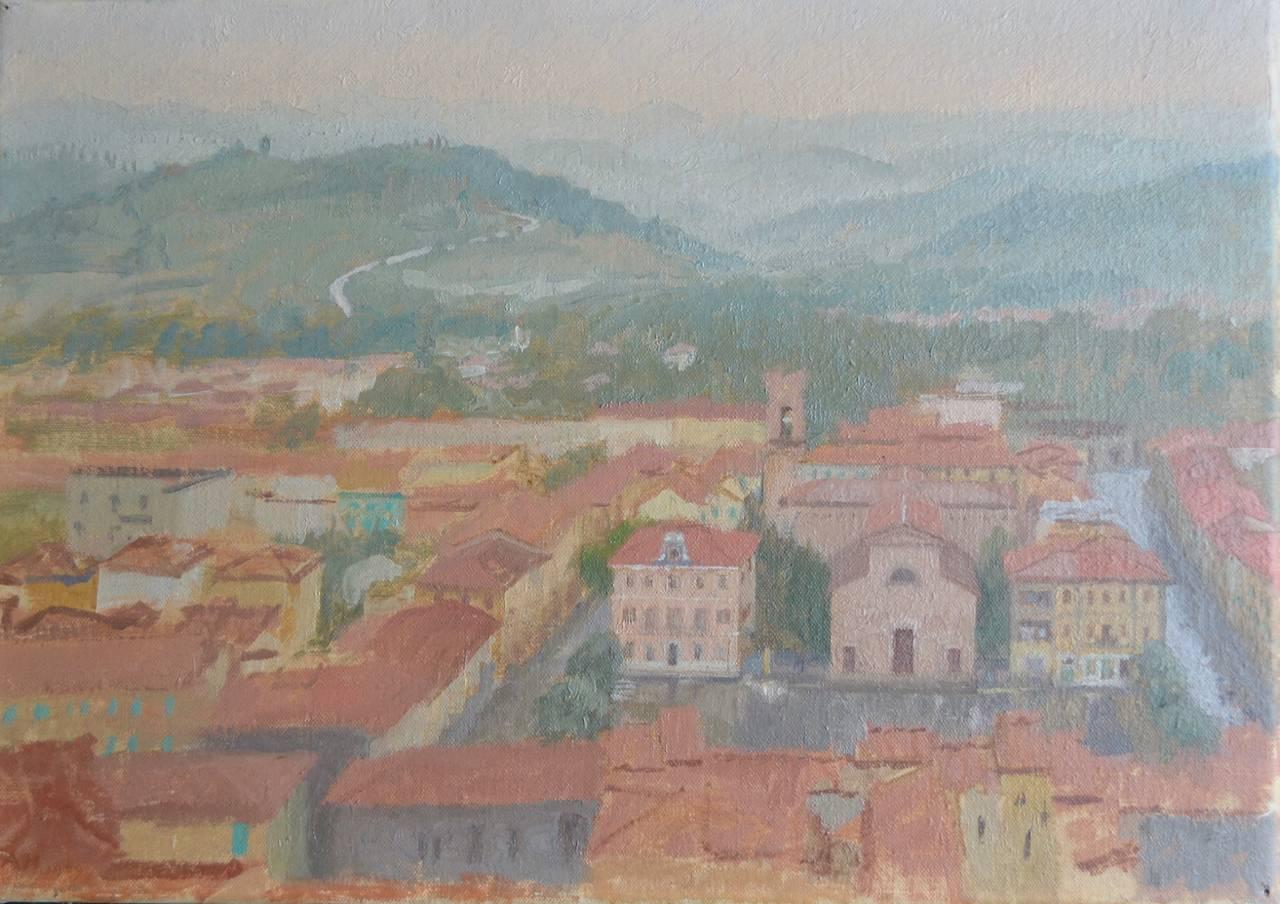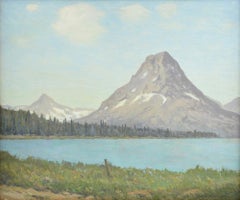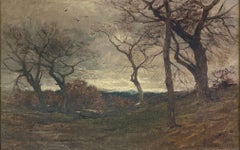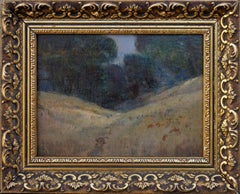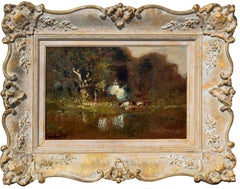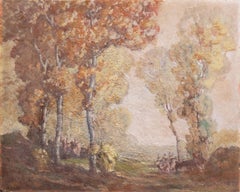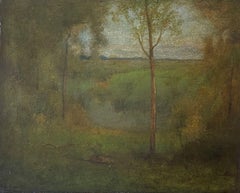
"The Marshes, New Jersey, " George Inness, Tonalist Montclair Landscape
View Similar Items
George Inness"The Marshes, New Jersey, " George Inness, Tonalist Montclair Landscapecirca 1883
circa 1883
About the Item
- Creator:George Inness (1825-1894, American)
- Creation Year:circa 1883
- Dimensions:Height: 28 in (71.12 cm)Width: 32 in (81.28 cm)
- Medium:
- Movement & Style:
- Period:
- Condition:
- Gallery Location:New York, NY
- Reference Number:1stDibs: LU184129918082
George Inness
George Inness, one of America's foremost landscape painters of the late 19th century, was born in 1825 near Newburgh, New York. He spent most of his childhood in Newark, New Jersey. He was apprenticed to an engraving firm until 1843 when he studied art in New York with Regis Gignoux, a landscape painter from whom he learned the classical styles and techniques of the Old Masters. In 1851, sponsored by a patron, Inness made a 15-month trip to Italy. In 1853, he traveled to France, where he discovered Barbizon landscape painting, leading him to adopt style that used looser, sketchier brushwork and more open compositions, emphaa sizing the expressive qualities of nature. After working in New York from 1854–59, he moved to Medfield, Massachusetts, and four years later to New Jersey, where through a fellow painter he began to experiment with using glazes that would allow him to fill his compositions with subtle effects of light. Duncan Phillips remarked on Inness’s mellow light as a unifying force, saying, “…he was equipped to modernize the grand manner of Claude and to apply the methods of Barbizon to American subjects." At this time also, Inness developed an interest in the religious theories of Emanuel Swedenborg, an 18th-century theologian who believed that all material things were imbued with spiritual presence and who proposed a philosophy in which earthly and heavenly realms are united. Inness's paintings throughout the decade of the 1860s showed sweeping, panoramic views of the Catskills, the Delaware Valley, or the New Jersey countryside. Despite their varying locales, these scenes share a spiritual expressiveness in the portrayal of nature’s moods, for example, dramatic effects of weather and atmosphere. In Inness’s mature paintings, the forms of the landscape become indistinct, hazy, abstracted, suggesting an existence in both material and immaterial worlds. Inness moved back to New York in 1867 and in 1868 was elected to full membership in the National Academy of Design, but being an inveterate traveler, he returned to Europe in 1870, living in Rome from 1871–75. Two years later he returned to New York, where he helped found the Society of American Artists. In 1878, he settled in Montclair, New Jersey, but continued to travel and paint misty, poetic, and evocative landscapes. Over the years, he went to a variety of locations in the eastern and southern United States, and to Cuba, California and Mexico. After 1880, his late synthetic landscapes were purely conceptual, made in a studio practice that relied on the memory of actual places but was fundamentally an embodiment in paint of the artist’s deepest feelings. With these dematerialized landscapes, attuned to the Transcendentalists, Inness pioneered an essential conceptualist art, one that would find echoes in the works of the Abstract Expressionists and Color Field painters of the 20th century. In 1894, Inness made his last trip abroad, visiting France, Germany, and Scotland, where he died. A public funeral was held in New York at the National Academy, which also held a large exhibition of his paintings that same year.
- "Mount Rockwell, Glacier National Park, Montana, " Mountain Lake Landscape ViewBy Charles Warren EatonLocated in New York, NYCharles Warren Eaton (1857 – 1937) The Shadow of Mount Rockwell, Glacier National Park, Montana, 1921 Oil on canvas 20 x 24 inches Signed lower right: CHAS WARREN EATON. Provenance: The artist The Macbeth Gallery, New York Private Collection Sotheby's New York, American Art, April 14, 1989 ConocoPhillips, Houston Simpson Galleries, Houston, Fine Art & Antiques, May 18, 2019, Lot 447 Exhibited: New York, The Macbeth Gallery, Paintings of Glacier National Park by Charles Warren Eaton, December 13, 1921 - January 2, 1922, no. 2. Literature: "Two Exhibitions at Macbeth's," American Art News, New York, Vol. XX, No. 10, December 17, 1921. A contemporary critic wrote that the paintings of Charles Warren Eaton appeal to “the dreamers who find in them the undiscovered scenes in which their fancy long has dwelt.” Eaton’s contemplative landscapes exude a spiritual quality that moves the observer into a similar frame of mind. He loved to depict the ethereal light of dawn and dusk in late autumn or winter, usually without any reference to human or animal figures or buildings. These Tonalist paintings, with their subdued palette and relatively intimate scale, marked a definite break with the fading popularity of the panoramic and romantic views of the Hudson River School painters. Charles Warren Eaton was born in Albany, New York to a family of limited means. He began painting while working in a dry-goods store. At age 22, he enrolled at the National Academy of Design in New York City and then studied figure painting at the Art Students League. By 1886, he was successful enough to quit his day job and make a living as a landscape painter. That year, he traveled to Europe with fellow Tonalist painters Leonard Ochtman and Ben Foster. In France, Eaton visited popular artist’s spots such as Paris, Fontainebleau and Grez-sur-Loing, and fell in love with the loose brushwork and moody style of French Barbizon painting. Returning to the United States, Eaton fell under the spell of George Inness, the foremost exponent of Barbizon style in the United States. In 1888, Eaton settled near Inness in Bloomfield, New Jersey, where Eaton lived until his death in 1937. In this period, he painted shadowy and ambiguous landscapes inspired by rural scenery in the northeastern United States. His signature theme was a cropped view of the branches, trunks, and foliage of a pine grove silhouetted against a delicately illuminated sunset or moonlit sky. He painted this vision so often between 1900 and 1910 that he picked up the sobriquet ‘‘The Pine Tree Painter.” After 1910, Eaton responded to the popularity of Impressionism by using brighter colors and painting sunlit daytime scenes. In 1921, he was hired to paint Glacier Lake, in Glacier National Park by the Great Northern Railroad Company as part of their ‘See America First’ campaign. He produced more than 20 paintings, among the artist's last works, that now poignantly remind viewers of the vast disappearing glaciers. Eaton tended to approach this mountain scenery from an oblique vantage point; he liked to capture small episodes, showing mountaintops nearly obscured by dramatically attenuated screens of fir trees. Eaton, like many Tonalist artists of his generation such as Henry Ward Ranger, John Francis Murphy, and Charles Melville Dewey...Category
1920s Tonalist Landscape Paintings
MaterialsCanvas, Paint, Oil
- "Stone Wall, Autumn, " George Smillie, Tonalist Fall Landscape ViewBy George Henry SmillieLocated in New York, NYGeorge Henry Smillie (1840 - 1921) Stone Wall, Autumn, 1879 Oil on canvas 9 1/2 x 15 inches Signed and dated lower right Provenance: Skinner, Boston, September 19, 2014, Lot 389 The career of George Smillie (1840-1921) followed the arc of nineteenth-century U.S. landscape painting. Trained in the Hudson River School tradition, Smillie successfully adapted to changing U.S. tastes and growing interest in European trends. In the late 1800s, he moved to tonalist paintings full of brushwork and influenced by French Barbizon painting. By the end of his career, he had lightened his palette to produce works similar to those of the U.S. impressionists. Yet in all styles, he was never less than competent, and his tonalist work is among the best produced in the United States. Like many nineteenth-century painters, George Smillie’s artistic training began with the study of printing. His father, James Smillie...Category
1870s Tonalist Landscape Paintings
MaterialsOil, Canvas
- "Autumn Landscape, " Bruce Crane, Tonalist American Impressionist Fall SceneBy Bruce CraneLocated in New York, NYBruce Crane (1857 - 1937) Autumn Landscape Oil on canvas 25 x 30 inches Signed lower right Robert Bruce Crane was an American painter. He joined the Lyme Art Colony in the early 190...Category
Early 20th Century Tonalist Landscape Paintings
MaterialsCanvas, Oil
- "November, " Bruce Crane, Tonalism Landscape Autumn Scene, American ImpressionismBy Bruce CraneLocated in New York, NYBruce Crane (1857 - 1937) November Oil on canvas 25 x 30 inches Signed lower right Robert Bruce Crane was an American painter. He joined the Lyme Art Colony in the early 1900s. His ...Category
Early 20th Century Tonalist Landscape Paintings
MaterialsOil, Canvas
- "Last Light, Landscape at Sunset, " William Keith, California Tonalist, ForestBy William KeithLocated in New York, NYWilliam Keith (1838 - 1911) Last Light, Landscape at Sunset Oil on canvas 25 x 30 inches Signed lower right A native of Scotland, William Keith became in the late 19th and early 20th centuries a leading Northern-California landscape artist. In fact, he was so well known that he is referred to as the "Dean of California painters." His romanticized views of nature found much favor among the culturally aspiring citizens of San Francisco and hung in many foyers and dining rooms in their elegant homes. He completed thousands of paintings and drawings, and many of them were lost in his studio in the fire of 1906. His early works are dramatic mountainscapes in a realistic style adopted from the Dusseldorf School of Germany. The paintings of the last two decades of his life are looser and obviously influenced by his exposure in France to the Barbizon School of landscape painters, who were the first colony of painters to complete paintings "en plein air," or directly from nature rather than in studios. A forerunner of Impressionism, this style also included Tonalism espoused by Barbizon painter Camille Corot [1796-1875] and also apparent in Keith's later works, which are darker, smaller, and much more intimate with emphasis on mood. Born in Aberdeenshire, Scotland, Keith came to New York with his family and, apprenticed to a wood engraver. In 1859, he moved to San Francisco where he worked for an engraver and later set up his own engraving business. Studying with Samuel Marsden Brookes in 1863, he determined to become a painter. He married artist Elizabeth Emerson and did watercolor painting with her guidance. In 1868, he became a full-time painter, and that same year was commissioned to paint scenes along the Columbia River including Mount Hood. By August 1869 he had sold enough paintings to finance an extended journey to the East Coast and Europe including Dusseldorf, Germany throughout most of 1870, studying with Albert Flamm. After a visit to Paris, he expressed great admiration for "the modern school of French landscape painting including the Barbizon School. During the winter of 1871-1872, the Keiths lived in Boston where they shared a studio with William Hahn. Keith's work received critical acclaim there and in New York at the National Academy of Design. In 1872, he returned to San Francisco. A friendship with naturalist John Muir exposed Keith to many remote places and in-depth knowledge of nature. During the 1870s, he painted several "epic" eight by ten-foot High Sierra views. He also visited Alaska, and his paintings of Alaska were exhibited upon his return to San Francisco in a show at the Bohemian Club, titled 'Dreams of Alaska'. Keith's Alaska works are significant because they are not close transcriptions of actual scenery, but rather are fantasies inspired by Alaska. They are important as they represent a major break from the documentary tradition in landscape painting of Alaska, as they show an interest in capturing its spirit versus just the topography. The first wife of William Keith died in 1882, and in 1883, he married Mary McHenry, the first woman graduate of Hastings Law School. They soon went to Europe, and Keith studied portrait painting in Munich with consultations from J. Frank Currier and Carl Marr for two years. Keith then settled for the remainder of his life in Berkeley, California, at 2207 Atherton Street. His studio was in San Francisco where he commuted daily, painted prolifically, and taught many classes, mostly for aspiring female artists . In 1891, he shared his studio for several weeks with East Coast Tonalist George Inness, Sr. [1825-1894]. Both men painted in a similar style and were followers of the mystical teachings of Swedenborg. Among the locations where Inness and Keith painted together were Monterey and Yosemite, and it was reported they discussed art from every possible angle. Under Inness' influence, Keith painted more than ever in a Barbizon-influenced vein with many sunset and twilight scenes. By the early 1900s, Keith was likely one of the wealthiest artists in the United States and certainly earned the most money of any California-based artist. People from all over the world sought out his studio where it was said that he would specially select a painting for a client from behind a black velvet curtain...Category
Late 19th Century Tonalist Landscape Paintings
MaterialsOil, Canvas
- "Verdant Summer Landscape, " Olive Parker Black, Tonalism, Female Artist StreamBy Olive Parker BlackLocated in New York, NYOlive Parker Black (1868 - 1948) Verdant Summer Landscape Oil on canvas 20 x 30 inches Signed lower left An accomplished landscape painter, Olive Black ...Category
Early 20th Century Tonalist Landscape Paintings
MaterialsOil, Canvas
- Late 19th Century Tonalist Landscape with Oak TreesBy Willard LeRoy MetcalfLocated in Soquel, CAGorgeous late 19th century Tonalist landscape painting of foothills and oak trees in the style of Willard Leroy Metcalf circa 1900. Inscribed "M" in circle monogram lower left corner and on frame verso. Presented in original rustic giltwood frame. Image size: 6"H x 8"W. Framed size: 8.5"H x 10.5"W. Tonalist are usually intimate works, painted with a limited palette. Tonalist paintings are softly expressive, suggestive rather than detailed, often depicting the landscape at twilight or evening, when there is an absence of contrast. Tonalist paintings could also be figurative, but in them, the figure was usually out of doors or in an interior in a low-key setting with little detail. Tonalism had its origins in the works of the French Barbizon school and in the works of American painters who were influenced by them. California Tonalism was born when the emphasis in California landscape painting passed from the grand landscapes of works like those of Thomas Hill and William Keith's early career, to more intimate views of a domesticated landscape. At the same time, the parallel Pictorialist Photography...Category
1890s Tonalist Landscape Paintings
MaterialsOil, Cardboard
$6,800 Sale Price20% Off - Cattle By Pond At Dusk, Mid-19th Century Tonalist Landscape by William KeithBy William KeithLocated in Soquel, CACattle By Pond At Dusk, Mid-19th Century Tonalist Landscape by William Keith Gorgeous mid-19th century landscape painting by William Keith (American, 1838-1911), circa 1860. This impressive Tonalist landscape, titled "In the Woods", depicts cattle beside a pond in the forest at dusk. Keith uses loose, blended brush strokes and a muted earthy palette to create an atmospheric mood that Tonalism is known for. Signed "W. Keith" lower left. Museum label on verso from Santa Barbara Museum of Art. Presented in an antique giltwood frame. Image size: 9"H x 13"W. With frame measures: 16"H x 20"W x 3"D. Provenance: Mrs. Eugene Patterson; Santa Barbara Museum of Art. Authenticity guaranteed and certificate include. Condition: Very good. Cleaning and restoration required signature to be re-touched, original images pre-restoration available. About the Artist: Brought to New York City in 1850, William Keith was apprenticed to a wood engraver in 1856 working for "Harper's" magazine. In 1858 (or 1859) he visited California for "Harper's" and then after a trip to Great Britain, settled in California as an engraver in 1862. He began exhibiting paintings in 1864 in San Francisco where he opened his studio, after having been taught painting by his wife. The Northern Pacific Railroad...Category
Late 19th Century Tonalist Figurative Paintings
MaterialsCardboard, Oil
$3,080 Sale Price20% Off - 'Nymphs at Dusk', Art Nouveau, Arts and Crafts, Tonalist Oil, Three Graces, AICLocated in Santa Cruz, CASigned lower right, 'Emerson' for William C. Emerson (American, 1865-1937) and dated 1910. Original card board, verso, was additionally signed 'W. C. Emerson' and titled, 'The Dance' (images included were taken prior to lay down). Displayed in a period, carved and giltwood frame; framed dimensions: 27.75 x 33.75 x 1.5 inches. Born in London, England, William Emerson...Category
1910s Tonalist Landscape Paintings
MaterialsCardboard, Oil, Masonite
- "Mountain Labyrinths"By John F. CarlsonLocated in Lambertville, NJAshley John is proud to offer this artwork by: John Fabian Carlson (1874/75 - 1945) John F. Carlson was one of the leading American landscape p...Category
Early 20th Century Tonalist Landscape Paintings
MaterialsCanvas, Oil
- Woodstock After the RainBy Leon DaboLocated in Lawrence, NYThis is an early work showing the mist still in the air after the rain has fallen. It is nearly abstract in its affect and describes what Dabo was, arguably, best known for: evanes...Category
1910s Tonalist Landscape Paintings
MaterialsOil
- Seashore, DawnBy Leon DaboLocated in Lawrence, NYLeon Dabo (1865-1960) enjoyed widespread acclaim in a career that stretched nearly a century. He was one of the primary students of Whistler and his work was a “virtual international style by 1910." He was an artist "who created works of decorative and spiritual abstraction that became icons of their age.” (David Cleveland, A History of American Tonalism...Category
Early 1900s Tonalist Landscape Paintings
MaterialsOil
